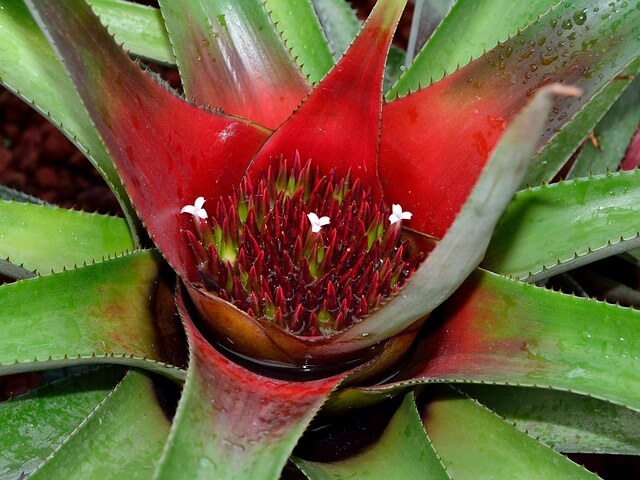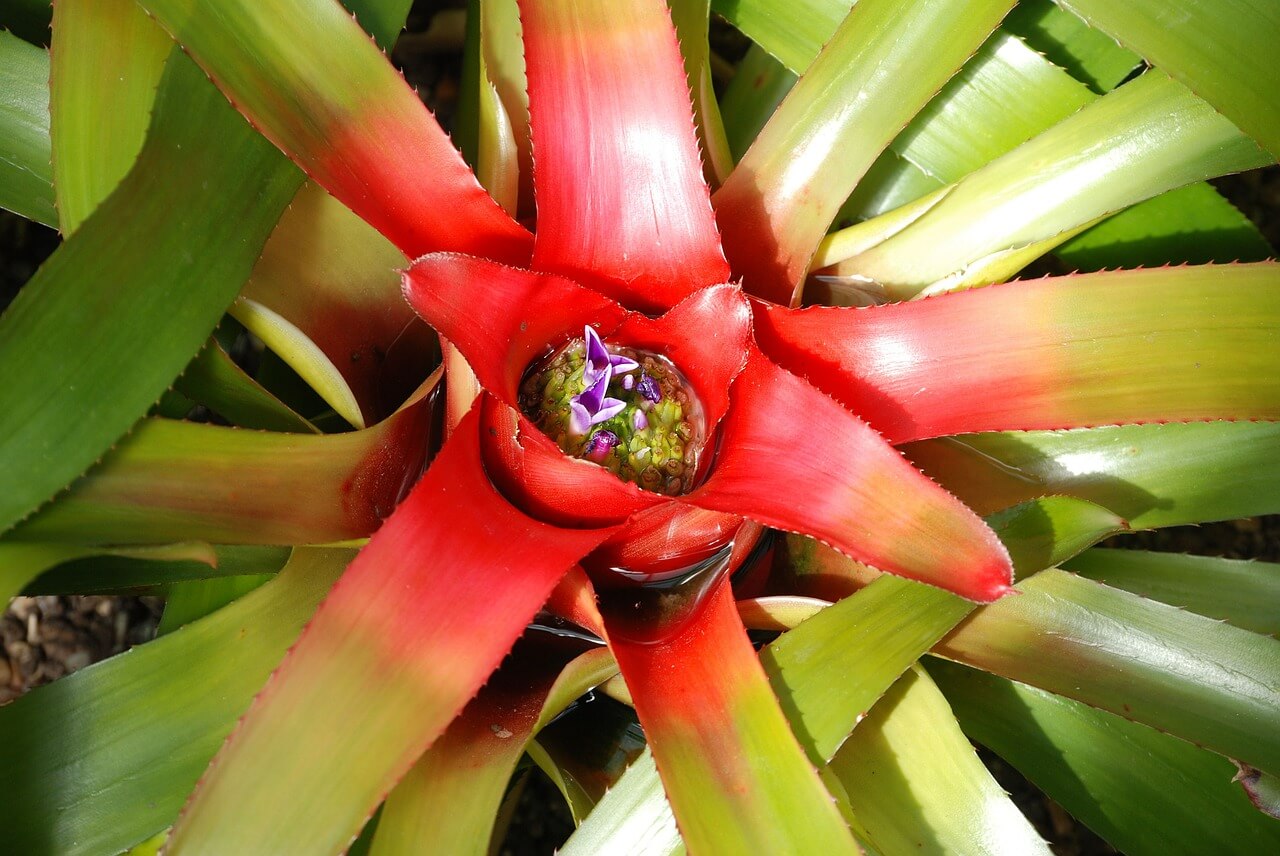Plant Care Instructions for Bromeliad Neoregelia, Bromeliad Neoregelia repotting, care tips, lighting, soil, watering, temperature tips.
Bromeliad Neoregelia
- Light: lots of light; no sun
- Temperature: 72° to 78° F – 22° to 26° C
- Humidity: 20% to 30%
- Soil: black and peat
- Watering: two or three times a week with tepid water at the centre of the plant
- Spraying: Weekly
These are rather spectacular members of the Bromeliad family. They have fine green foliage and bright red inner leaves. They are also easy to grow. Abundant small flowers, white or purplish-blue, appear on the red part of the foliage.
As with most Bromeliads, after flowering, young shoots appear at the base of the mother-plant. Separate these shoots, taking as much root as possible, and transplant them into a good soil.
This plant needs warmth but not too much moisture. If you put it in a very dry spot you must make sure there is always some water at the heart of the plant. Rainwater should be used, if possible. If you use tap water, boil it for three to five minutes to eliminate lime. Use this water at room temperature.
Do not put the plant in the sun. Repot the plant after it blooms and then allow it to rest without fertilizer for quite a long time.

Source : pixabay.com
Tips for caring for Neoregelia plants: bromelia with striking foliage
These bromeliads with striking and colorful foliage are easy-to-use indoor plants and will brighten any home. Here you will find tips on caring for Neoregelia plants.
Neoregelias, of which there are many species and varieties, are my favorite bromeliads. Why do you ask? I love them for their amazing foliage that comes in a variety of colors and patterns. I grew them outdoors in my garden in Santa Barbara and seeing these vibrant and interesting plants made me smile all the time. All this is about growing them in the interior: these tips for the care of Neoregelia plants will help you maintain your health and look splendid.
I recently made publications in Aeachmea, Pink Quill Plant and Guzmania, all of which are favorites for their striking flower heads. What excites me about the Neoregelias is that the foliage is the star, which means that this plant looks very good for the long term. The violet blue flowers are found inside the urn, the vase, the tank or the cup (the well in the center of the plant gets many names) and they are not the reason why this Bromeliad is so popular.
Neoregelia plant care tips:
Light:
The bright and natural light is the best, as an east or west exposure. Neoregelias need this light to highlight the variegation in its foliage. The 1 you see in the video may take a little less, while other varieties with extravagant foliage need more light. Those could handle an exposure to the south. Either way, be sure to keep them out of the hot, direct sun because they will burn.
Water:
These, like the Aeachmea, have very definite urns. In nature, Neoregelias collect and absorb water in their urns and also through their foliage. Its roots are mainly to anchor them in other plants or whatever they are growing. You want to keep the urn about 1/4 full. If you keep it full, especially in the winter months, the center tends to rot.
Keep even less water in the tank in low light or cold temperatures. You do not want the plant to be discouraged. I let the cup dry for 2-7 days before refilling it with a little water.
You want to rinse the ureter every month with fresh water, otherwise it stagnates and bacteria start to appear. I also moisten the growing medium every month or 2. Because these plants grow in the subtropics and the tropics, they would appreciate a good nebulization once a week. If your house is really dry, then 2 or 3 times will make your Neoregelia even happier.
Do not overwater your bromeliad. Like other indoor plants, it recedes a bit in watering in the colder and darker winter months. And, if your water is hard, be sure to use purified or distilled water.

Source : pixabay.com
Fertilizer
The Neoregelias obtain their nutrients from the matter that falls from the plants that grow up. For this reason, it is better to spray the fertilizer on the foliage and moisten the upper half of the growth medium. You can use a food for multiple-use orchids (orchids are epiphytes such as bromeliads) diluted in 1/2 strength or this fertilizer formulated for air plants.
I never fertilize my bromeliads because I feel they do not need them. If your Neorgelia does it, just make sure you do not put too much fertilizer in the urn. The salts can accumulate and cause burns. Just feed in the spring or summer, and it’s easy to do it. Fertilizing once or twice a year is enough.
Growing medium:
All bromeliads need excellent drainage. In nature, they receive moisture from frequent rains, but the water is washed immediately. Use the bark of orchids (small, medium or large) or the mixture of cymbidium orchids, as well as a mixture of orchid and coconut bark. This is a more sustainable substitute for peat. Just make sure your mix runs out really well.
Propagation / Replanting:
Neoregelias do not have extensive root systems, so you probably do not have to disseminate yours.
Like other bromeliads, puppies (baby plants) are formed outside the mother plant. I discovered that the mother plant of Neoregelia actually lasts for a long time before producing those puppies. You can leave the puppies attached to the parent plant and gradually cut the foliage as it dies or remove the pups with a sharp and clean knife when they grow old enough.
The death of the mother plant is only the natural cycle through which a bromeliad passes. You can put them in a pot or mount them on the bark or floating wood. By the way, the puppies grow slowly and do not flower for at least 3 years.
Humidity / Temperature:
As I say, if your house is comfortable for you, it will be comfortable for your indoor plants. Neoregelias seem to handle the dry air in our homes surprisingly well, but they would definitely love a mist or fumigation once or twice a week. This also helps prevent dust from accumulating in the foliage.
Pet insurance:
From everything I’ve read and heard, Neoregelias are not toxic to cats and dogs. Its leaves are crispy and this may be attractive to cats. It can make your kitten a little sick, but it is not poisonous.